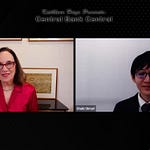Charles “ Charlie” Evans is a lifelong central banker. He joined the Chicago Fed in 1991, and rose through the economics ranks to become director of research, and finally in 2007 was appointed as the President of the bank, a position he held until early 2023, meaning he was a top Fed official during both the Great Financial crisis and the unprecedented policy steps taken during the Pandemic.
And even Charlie is not sure how big the Fed’s widely expected September rate cut will be, how many there will be this year, and perhaps most important what kind of messaging Chair Powell will send when that first rate cut of the cycle is made. He says the Fed will need to accompany any rate cut or cuts they make in September with a new and improved communication strategy
”I think they’re clearly leading up to making adjustments to the policy in September,” he says. “But then the question is how much, how quickly?”
Charlie points to the big pivot the Fed made at the beginning of the year when markets were looking for six rate cuts and the inflation numbers started reaccelerating. Powell and his colleagues started saying that they need to see inflation not just heading lower but heading “sustainably” toward 2%. But what does that mean now? Will the Fed push rates down step by step without hesitation? Or be wary of moving too fast if Fed has not reached 2%?
His views I think take us in inside the mind of Fed officials, to the kind of debates they are having now as wait for more inflation and jobs numbers and get ready for their mid-September policy decision.
”I think really the the bigger questions are, where are they going? You know, where are they going with policy over the next…many months in a year? Because …Jay Powell said that, well, we need to be careful. We have to, you know, meet our inflation objective,” he says.
”And we know that the first cut will be consequential. It’s going to be important.
And, you know, markets understand that because when you make the first cut and how many more, how quickly are they going to be? What's the size of them going to be?”
Charlie has been leaning toward rate cuts in public comments he has made, including right after the release of the July employment report which included the jump in the unemployment rate which revved up recession fears and kicked off the stock market tailspin that led to emergency rate cuts calls. He has seen the Fed Funds rate at 5.3% as inflation steadily comes down as restrictive and ample justification for a cut, including in September.
For the record, Charlie does see the July jump in unemployment as a possible sign the labor market is on the verge not just of “normalizing” but of starting to weaken more dramatically. At the same time, labor market indicators like weekly jobless claims which have fallen back after jumping for a couple of weeks as one of the signs the labor market is still on solid ground. He does not think the economy is in recession now especially after seeing a pretty solid July retail sales report.
He does caution however that if the neutral rate is now around 3%, and the economy does start slowing down sharply, heading for negative territory with the fed funds rate at 5.3% then the Fed will be in the tough position of having to move farther and faster with rate cuts.
I did ask Charlie about the immediate - and to some - extreme calls from market participants for an emergency Fed rate cut of as much as 75bps. Could this happen? This is not February 2020 at the beginning of the Pandemic when the bond market was seizing up. Were these calls overdone, unrealistic?
You haveto hear his answer. He gave me a detailed history of big series of emergency rate cuts the Fed has done over the years, emphasizing that if and when things do move quickly in the economy and the markets, the Fed has been ready to move quickly too.
Take the time to listen to Charlie, get to know him and his views, and the kind of analysis that gets him there. It’s a tricky time for the Fed. And only a veteran like this who has been there, done this can helps us see this from the inside out.
Dr. Charles L. Evans joined the Chicago Fed in 1991 and served as President of the bank starting September 1, 2007. He previously served as director of research and senior vice president, supervising the Bank’s research on monetary policy, banking, financial markets and regional economic conditions as well as its community development and public affairs functions.
As a researcher at the Chicago Fed, Evans’ work focused on measuring the effects of monetary policy on U.S. economic activity, inflation and financial market prices. The model he developed in collaboration with Martin Eichenbaum and Lawrence Christiano of Northwestern University serves as the foundation for models used at central banks around the world today. His research has been published in the Journal of Political Economy, American Economic Review, Journal of Monetary Economics, the Handbook of Macroeconomics, and the Brookings Papers on Economic Activity, and includes articles that are among the most cited in the field of monetary economics.
Evans’ research background helped guide his views as a policymaker. This was evident in the monetary policy strategies he promoted during the periods in his tenure when the federal funds rate was constrained by the effective lower bound on interest rates. He consistently advocated policy focusing on doing what was necessary to achieve the Federal Reserve’s dual mandate objectives, which might dictate following somewhat unconventional practices to deal with difficult economic conditions. In that vein, following the Great Financial Crisis, Evans proposed that the Federal Open Market Committee change its broad forward guidance to a threshold-based approach that linked future policy moves more explicitly to unemployment and inflation outcomes. He was also a strong supporter of transparent communication by the Committee and served on the FOMC communications sub-committee that developed the “dot plot” the FOMC now publishes showing participants’ views of appropriate monetary policy.













Share this post